Difference between revisions of "FP11-A Floating-Point Processor"
(clarify) |
(clarify "high half") |
||
| Line 3: | Line 3: | ||
The '''FP11-A Floating-Point Processor''' is the optional [[hardware]] [[floating point]] unit for the [[PDP-11/34A]] ([[KD11-EA CPU|KD11-EA]] [[Central Processing Unit|CPU]]). It consists of a single [[DEC card form factor|hex]] board, the '''M8267'''. It supports the full [[PDP-11]] [[FP11 floating point]]. | The '''FP11-A Floating-Point Processor''' is the optional [[hardware]] [[floating point]] unit for the [[PDP-11/34A]] ([[KD11-EA CPU|KD11-EA]] [[Central Processing Unit|CPU]]). It consists of a single [[DEC card form factor|hex]] board, the '''M8267'''. It supports the full [[PDP-11]] [[FP11 floating point]]. | ||
| − | The FP11-A uses a bank of 16 [[Am2901 Four-Bit Microprocessor Slice]] [[integrated circuit|chips]] to perform all its computations; the main CPU is also used in floating point [[instruction]]s, to load and store [[operand]]s in [[main memory]], etc. Both are [[microcode]]d; the microcode width is 48 bits in each. The microcode for floating point instructions for the CPU is contained on the CPU's M8266 card; the portion of the microcode there used for floating point instructions is the high half. | + | The FP11-A uses a bank of 16 [[Am2901 Four-Bit Microprocessor Slice]] [[integrated circuit|chips]] to perform all its computations; the main CPU is also used in floating point [[instruction]]s, to load and store [[operand]]s in [[main memory]], etc. Both are [[microcode]]d; the microcode width is 48 bits in each. The microcode for floating point instructions for the CPU is contained on the CPU's M8266 card; the portion of the microcode there used for floating point instructions is the high half of the microcode [[address space]] (which is increased by one bit in the KD11-EA over that in the [[KD11-E CPU|KD11-E]]). |
The FP11-A's connections to the KD11-EA include two [[over the back]] connectors; a 20-pin connector to the M8265 card of the KD11-EA, and a 10 pin connector to the M8266 card. (This was likely because the [[PDP-11/34]] could be field-upgraded from a [[KD11-E CPU]], which did not support the floating point unit, to a KD11-EA, which did - but its original [[DD11-P backplane]] was retained.) | The FP11-A's connections to the KD11-EA include two [[over the back]] connectors; a 20-pin connector to the M8265 card of the KD11-EA, and a 10 pin connector to the M8266 card. (This was likely because the [[PDP-11/34]] could be field-upgraded from a [[KD11-E CPU]], which did not support the floating point unit, to a KD11-EA, which did - but its original [[DD11-P backplane]] was retained.) | ||
Revision as of 11:13, 9 February 2022
The FP11-A Floating-Point Processor is the optional hardware floating point unit for the PDP-11/34A (KD11-EA CPU). It consists of a single hex board, the M8267. It supports the full PDP-11 FP11 floating point.
The FP11-A uses a bank of 16 Am2901 Four-Bit Microprocessor Slice chips to perform all its computations; the main CPU is also used in floating point instructions, to load and store operands in main memory, etc. Both are microcoded; the microcode width is 48 bits in each. The microcode for floating point instructions for the CPU is contained on the CPU's M8266 card; the portion of the microcode there used for floating point instructions is the high half of the microcode address space (which is increased by one bit in the KD11-EA over that in the KD11-E).
The FP11-A's connections to the KD11-EA include two over the back connectors; a 20-pin connector to the M8265 card of the KD11-EA, and a 10 pin connector to the M8266 card. (This was likely because the PDP-11/34 could be field-upgraded from a KD11-E CPU, which did not support the floating point unit, to a KD11-EA, which did - but its original DD11-P backplane was retained.)
Installation
This is mostly covered here. The latter over-the-top connector uses the connectors on the M8266 card which normally hold the maintenance cables to the KY11-LB Programmer's Console; in systems with a KY11-LB, the cables to the console will now connect to the M8267 card. (This is all necessitated because the FP11-A needs access to signals carried over the maintenance cables.)
For hardware debugging/repair, when the M8267 card is normally placed on a hex extender card to allow physical access to internal signals, a special W9042 Extender Board exists, to be used in place of the usual over the back connector, when so doing.
External links
- FP11-A floating-point processor user's guide (EK-FP11A-UG-001)
- FP11-A floating-point processor technical manual (EK-FP11A-TM-002)
- FP11-A Field Maintenance Print Set (MP00189) - contains the FP11-A microcode on pp. 42-89
